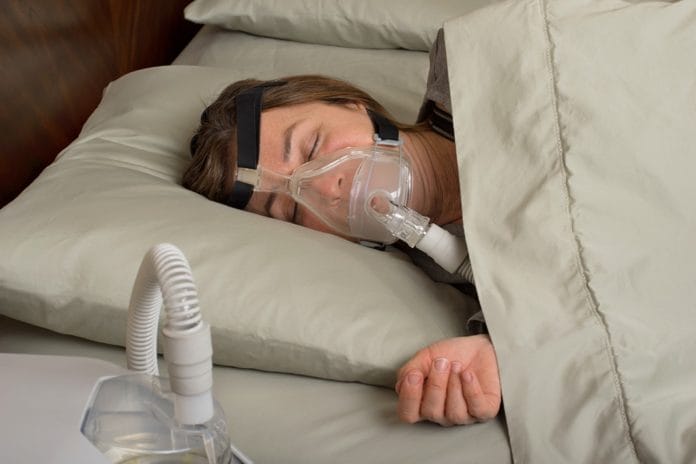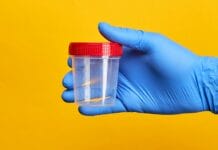Sleep apnea has become a growing health concern because of its link to other potentially fatal health conditions. Sleep apnea occurs when there are pauses in the breathing of people sleeping, and may result in the sufferer waking and gasping for air. As dental clinicians, we have the ability to evaluate our patients for potential sleep disorders, based on the patients’ health histories or physical markers. Our diagnoses may prevent future serious health conditions.
Sleep Apnea is characterized as “mild,” “moderate,” or “severe” based on the number of disruptions in sleep per hour1. Mild sleep apnea is five to fifteen pauses of breath per hour, moderate is fifteen to thirty pauses of breaths per hour, and severe is more than thirty pauses of breaths per hour. These disruptions can be monitored and recorded through a clinical sleep study or with a home sleep testing device (HSTD). The clinical sleep study is conducted under physician supervision with the patient staying overnight in a clinical setting, whereas the HSTD is provided by a dentist or physician and is used at home. Although the home device has the advantage of the patient’s sleep being monitored in the comfort of one’s own home, it is important to have a trained physician to monitor and evaluate the results.
According to the American Heart Association, sleep apnea is divided into three types: Obstructive Sleep Apnea (OSA), Central Sleep Apnea (CSA), and Complex Sleep Apnea Syndrome (CSAS)1. OSA occurs when the air flow is blocked by weight on the upper chest or neck. Although this is typically associated with obesity, sleep position also plays a role. Second, CSA occurs when the brain does not send a signal to the diaphragm to contract and expand, thus causing pauses in the subject’s breath. Last, CSAS is a combination of Obstructive and Central Sleep Apnea.
Heart disease is the leading cause of death in the United States, and sleep apnea has not only been associated with high blood pressure, arrhythmia, and stroke but with heart failure as well1. Sleep apnea increases the risk for high blood pressure, also known as the “silent killer,” and high blood pressure, in turn, can cause sleep apnea2. Therefore, treatment for OSA may decrease high blood pressure levels. Research has concluded thirty-five percent of sleep apnea patients have high blood pressure which can increase their risk of dying of a heart-related disease by five percent3.
Alarmingly, cardiovascular disease affects forty-seven to eighty-three percent of those suffering from sleep apnea while twelve to fifty-three percent are affected by heart failure, atrial fibrillation, and stroke3.
Sleep apnea is most common in middle-aged adults between the ages of thirty and seventy years and affects men more than woman2. However, children are also a rising concern. Commonly, children with behavioral problems, lack of concentration and inattentiveness have been diagnosed with ADHD (Attention Deficit Hyperactive Disorder) and then treated with medication to suppress these symptoms.
Surprisingly, recent research has indicated these common ADHD symptoms are similar to the symptoms of sleep apnea. Clinical research has concluded fifty to ninety percent of children who suffer from sleep disorders also develop ADHD-like symptoms4. Lack of sleep can also damage the brain neurons due to a decrease in oxygen and an increase in carbon dioxide. This interference in the sleep process disrupts the cellular and chemical systems of the brain4. Poor sleep can also compromise the immune system.
Other recent medical conditions that are associated with sleep apnea are type 2 diabetes, Alzheimer’s, and dementia. The association of diabetes to sleep apnea is most likely related to the common risk factor of obesity. Studies have shown sixty to eighty percent of patients suffering from OSA have been diagnosed with type 2 diabetes5. Sleep apnea can also cause memory problems, such as dementia, which is the result of a decrease in oxygen levels supplied to the brain6. Finally, Alzheimer’s disease is caused by toxic plaque which develops in the brain, and lack of sleep contributes to this toxic plaque development, therefore accelerating the progression of Alzheimer’s disease7. It is important to keep in mind that other biological factors also contribute to these conditions.
Treatment of sleep apnea first requires monitoring sleep activity and determining the severity of the sleep disorder. A device called the CPAP (Continuous Positive Airway Pressure) is worn nightly to prevent sleep apnea episodes. The CPAP creates a positive continuous airflow pressure to keep the airway open. It is the most effective treatment for all types of sleep apnea.
Another device used to treat this disease is the MAD (Mandibular Advancement Device) which is constructed by a dentist. It positions the jaw forward in order to prevent blockage to the airway. Although the MAD appliance is effective, it is limited to treating OSA8. However, the benefits of MAD in comparison to the CPAP machine is the MAD is customized to fit each individual, and there are no respiratory side effects, such as xerostomia or thrush. The MAD device is also silent, non-cumbersome, and typically less expensive than the CPAP machine.
I am fortunate to work in a dental office which provides its patients with screening and information related to sleep apnea. After assessing the patients for possible symptoms of OSA, we then provide them with the at-home screening device to monitor their sleep habits over a six-hour period. The machine records the data, and then the data is sent to a physician who evaluates the results and determines the best treatment for these individuals. Next, the patients return for appointments with the dentist to review the findings; if the diagnosis is mild to moderate OSA, an impression is taken, and the patients then return for delivery of their MAD dental appliances. If the results indicate severe OSA or CSA, the dentist will recommend the patient seek treatment with a physician specializing in sleep disorders.
As dental clinicians, we have the opportunity, at least twice a year with compliant patients, to monitor the signs and symptoms of a possible sleep disorder. The patient’s medical and dental history can tell us the history of heart disease, diabetes, and other related symptoms which may result in the patient suffering from a sleep disorder. A patient’s weight, age, family history, and gender are also risk factors. Other dental-related risk factors include jaw structure, size of the neck, enlarged tonsils or tongue, gastroesophageal reflux, and deviated septum9. Finally, an immediate tell-tale sign is obstructive breathing exhibited by the patient when the patient is placed in a supine position during dental treatment.
The evolution of medical and dental links to sleep apnea provides patients with an advantage of treatment in the early stages of the disease. It is important for dental clinicians to be aware and well-informed of the medical and dental conditions of sleep apnea. Screening patients in the dental setting may provide the information needed for the patients to seek the proper treatment which will prevent them from experiencing a serious or fatal result. Our effective role as dental clinicians will allow us and our patients to sleep well at night.
Need CE? Click Here to Check Out the Self-Study CE Courses from Today’s RDH!
Listen to the Today’s RDH Dental Hygiene Podcast Below:
References
- American Heart Association (2018). Sleep Apnea and Heart Disease, Stroke. March 16, 2018. Retrieved from www.heart.org
- Cardiosmart American College of Cardiology (2015). Sleep Apnea And HBP: A Dangerous Pair. May 1, 2015. Retrieved from www.cardiosmart.org
- Harvard University (2013). How Sleep Apnea Affects the Heart. Febuary 2013. Retrieved from www.health.harvard.edu/heart/how-sleep-apnea-affects-the-heart
- Chai Woodham (2012). Does Your Child Really Have ADHD?. June 20,2012. Retrieved from https://health.usnews.com/health-news/articles/2012/06/20/does-your-child-really-have-adhd
- Sushmita Pamidi (2017). Effects of Oral Appliance Therapy on Glucose Levels in Patients with T2DM and OSA= A Pilot Study. May 30, 2017. Retrieved from https://clinicaltrials.gov/ct2/show/NCT03167684
- Common Sleep Problem Linked to Dementia. Retrieved from https://www.alzoinfo.org/articles/common-sleep-problem-linked-dementia/
- Jessica Hamzelou (2009). Lack of sleep linked to Alzheimer’s. Sept.24, 2009. Retrieved from https://www.newscientist.com/article/dn17853-lack-of-sleep-linked-to-alzheimers
- Yoshikzu Takaesu, PhD; Satorutsuiki, PhD; Mina Kobayashi, PhD; Yoko Komada, PhD; Hideaki Nakayama, PhD; Yui Chi Inoue, PhD. Mandibular Advancement Device as a Comparable Treatment to Nasal Positive Airway Pressure for Positional Obstructive Sleep Apnea. Retrieved from jcsm.aasm.org/viewabstract.aspx?pid=30743
- Wikipedia. Definition of Sleep Apnea. Retrieved from https://en.wikipedia.org/wiki/sleep_apnea










